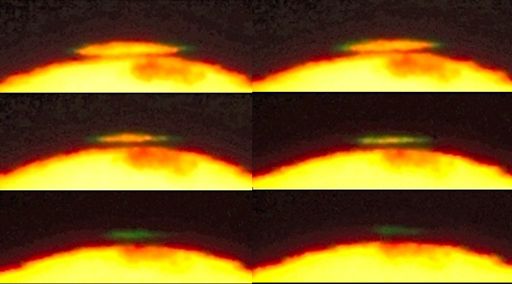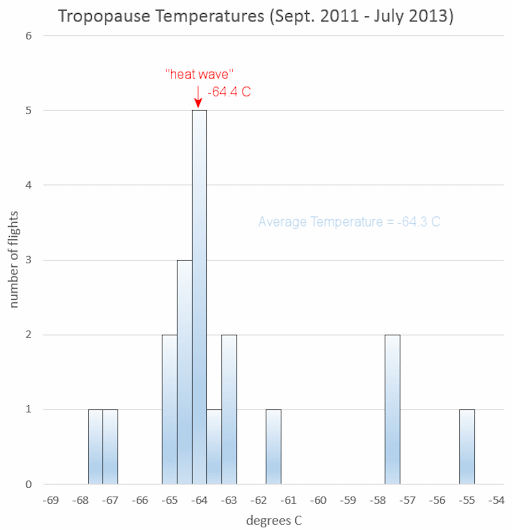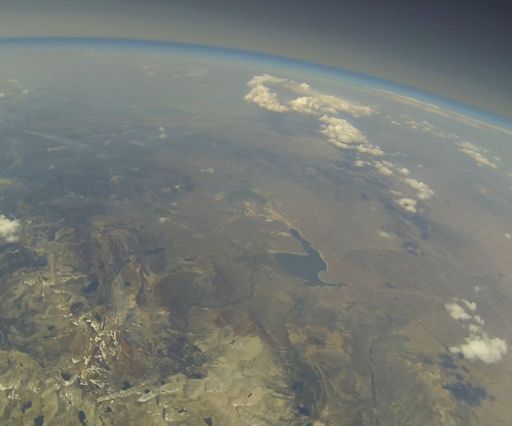When is the best time to see auroras? Where is the best place to go? And how do you photograph them? These questions and more are answered in a new book, Northern Lights - a Guide, by Pal Brekke & Fredrik Broms. | | |
CONTEST! WAVE AT SATURN, WIN A TELESCOPE: On July 19th, the Cassini spacecraft will photograph Earth through the rings of Saturn. NASA hopes people will go out and wave at Saturn during the photoshoot. How about waving at Saturn from the edge of space? Enter the Wave at Saturn Contest and your idea to commemorate Cassini's snapshot could be flown to the stratosphere on July 19th. Winners will receive free telescopes from Explore Scientific. Enter now!
CME PASSAGE: Magnetic fields in the solar wind intensified on July 13th, indicating the possible passage of a minor CME past Earth. The encounter did not immediately trigger geomagnetic storms. NOAA forecasters remain optimistic, however, placing the odds of a polar geomagnetic storm on July 14th at 65%. Update: Auroras were observed in Wisconsin last night. Aurora alerts: text, voice.
GREEN FRAGMENT BREAKS OFF THE SUN (NOT REALLY): On July 12th, nature photographer Jim Young was watching the sun set over the Pacific Ocean west of Seaside, Oregon, when a green fragment broke away from the solar disk. His camera, a Canon 60Da, started taking pictures every 1/1000th of a second to record the event:

Appearances notwithstanding, the sun is still intact. What happened? The green color of the eruption is the key clue.
"It was a green flash," explains Young, "caused by refraction in the atmosphere over the Pacific ocean."
The Pacific is a great place to find green flashes. Temperature gradiants in the air above the sea surface magnify tiny differences in the atmospheric refraction of red and green light, creating a verdant mirage.
There was a time when green flashes were thought to be fables, but now we know they are real. Jules Verne popularized the phenomenon in his 1882 novel "Le Rayon Vert" (The Green Ray). He described "a green which no artist could ever obtain on his palette, a green of which neither the varied tints of vegetation nor the shades of the most limpid sea could ever produce the like! If there is a green in Paradise, it cannot be but of this shade, which most surely is the true green of Hope." 131 years later, Young is hoping for more.
Realtime Green Flash Photo Gallery
SPACE WEATHER BALLOON UPDATE: Last month, a record-setting heat wave swept across the southwestern USA, with temperatures in Death Valley and surrounding areas jumping as high as 54 C (129 F). The student scientists of Earth to Sky Calculus decided to find out if the heat wave extended all the way to the edge of space. So, on June 30th when the temperature in their hometown Bishop, CA, was 42 C (108 F), they launched a research balloon to the stratosphere. An onboard cryogenic thermometer measured the temperature all the way up to 90,000 feet above sea level. This is what they found:
The heat wave did not reach into the stratosphere.
During the flight, the thermometer registered a low temperature of -64.4 C. This occured when the balloon passed through the tropopause, the boundary layer between the troposphere and the stratosphere. The tropopause is the coldest part of the atmosphere, and on the day of the heat wave it was just as cold as usual. Consider the following histogram:

Since 2011, the Earth to Sky students have flown 30 balloons and measured the temperature of the tropopause 19 times. The histogram is a summary of their thermal database, which spans all four seasons and all 12 months of the year. The temperature of the tropopause on June 30, 2013, fell right in the middle of the distribution--nothing unusual. These results show that hot air on the ground does not necessarily translate into a hot upper atmosphere.
There was, however, something unusual about the flight. Normally, air above the Sierra launch site is crystal clear, but not this time. En route to the stratosphere, the balloon encountered many thin layers of smoke and ash blown into the area from distant wildfires. Each fire, apparently, lofted its aerosols to a different altitude where winds stretched the smoky debris into a thin layer. This picture was captured while the balloon was in transit between two layers:

Note the curved blue line. That's the narrow gap between the two aerosol layers, allowing a glimpse of blue sky in the distance. (To residents of the eastern Sierra: That's Crowley Lake in the foreground.)
This was a curiosity-driven experiment conducted by high school students. Learn more about the Earth to Sky Calculus program at the group's Facebook page.
Realtime Space Weather Photo Gallery
Realtime Aurora Photo Gallery
Realtime Noctilucent Cloud Photo Gallery
[previous years: 2003, 2004, 2005, 2006, 2007, 2008, 2009, 2011]
Realtime Comet Photo Gallery

